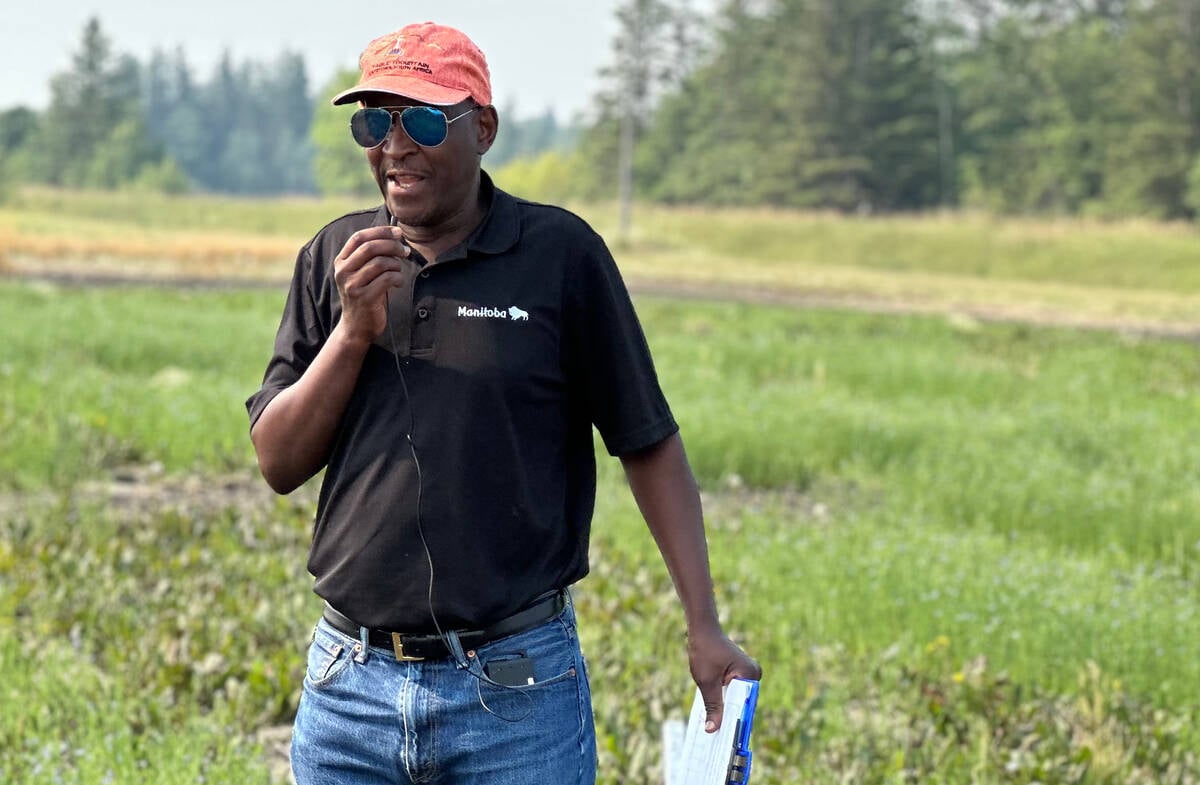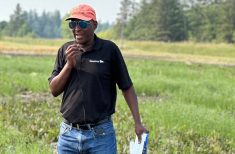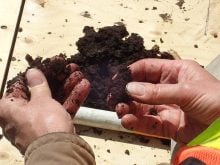Manitoba expat Barney Geddes, an assistant professor with the microbiological sciences program at North Dakota State University, likes to tell health care researchers how important the development of nitrogen fertilizer was.
In terms of human lives saved, it’s had a greater impact than all innovations produced by medical science put together.
“It’s sort of entertaining,” he said. “It depends on how you put the numbers together but, in truth, half of the world is actually fed by synthetic fertilizer.”
Read Also

How much nitrogen can farmers really cut?
Manitoba fertilizer trials look for nitrification inhibitor sweet spot, to lower greenhouse gas emissions and cost without hurting yield.
Why it matters: Work in North Dakota could expand soil testing beyond chemistry to include soil biology, helping farmers make better decisions on a field by field basis.
Synthetic fertilizers are an extension of a relationship dating back to the Archean Eon (between 4,000 and 2,500 million years ago) when the first simple microbes learned to crack atmospheric nitrogen and fix it to hydrogen.
This early skill enabled them to manufacture protein and made all life on Earth possible, and mankind created an agricultural revolution when it learned how to fix nitrogen synthetically.
“Now, the problem is that they’re getting really expensive, probably the most expensive input for a lot of farmers,” Geddes said.
There is a host of factors attached to the cost of nitrogen, from environmental demands to world politics and domestic government policies.
There is also the Canadian government’s plan to reduce nitrogen fertilizer emissions as measured in 2020 by 30 per cent by the end of the decade. Farmers are being pushed to find new approaches for nitrogen management, while maintaining enough supply of fixed nitrogen to keep up production.
In the North Dakota research program, legumes and their ability to convert atmospheric nitrogen into usable nutrient through root nodules are the cornerstone of one approach. More specifically, it’s all about the rhizobia bacteria that make fixing nitrogen possible.
Geddes and his lab team are taking a detailed look at legume rhizobia bacteria, in the hope they can learn how to use them more effectively.
“The agronomic outputs from our programs focus on two major questions,” he said. “One is, can we guide farmers on when they can inoculate their fields and when can they expect to see benefits from inoculation? The second is, can we improve on the technology that’s out there? Can we actually maximize the benefits we get from inoculation?”
The problem is that crop inoculants don’t come in a one-size-fits-all package. Each crop demands a specific species of rhizobia and they’re not cross compatible. Soybean, for example, associates with Bradyrhizobium bacteria, compared with chickpeas, which need Mesorhizobium.
The relationships are unique enough that Geddes said each must be studied on its own.
Lingering populations
A commercial inoculant delivers the right rhizobium for the right crop, but since that product is a living organism, how long does a sustainable population last after a crop of soybean? Do farmers need to inoculate again?
“Different people have different responses for different reasons,” Geddes noted. “Some people would say you should always inoculate.”
It is “cheap insurance,” he added, particularly compared to the cost of fertilizer.
Studies done at the Carrington Research Extension Centre in North Dakota’s Red River Valley show that a field inoculation can last up to five years. Another inoculation may not deliver a yield boost because there is already a residual population of rhizobia in the soil.
Environmental factors also have roles.
“Events like drought or flooding are hard for rhizobia and can deplete their populations,” Geddes said. “Soil conditions like acidic pH or salinity are also challenging for establishing symbiosis between the host and symbiont.”
Iron deficiency chlorosis in soybeans also seems to disrupt the symbiosis and may slow nodule growth.
A plant will also avoid burning its own energy to build nodules if it doesn’t need to, such as when soil nitrogen is already high.
A biological test to determine the right bacteria and how much of it is in the field would therefore be helpful to farmers’ planning.
Could the industry move past basic chemical soil testing and take it into the realm of biological analysis? Could it use a Polymerase Chain Reaction (PCR) test, similar to what is used for COVID-19, that would allow a small genetic sample to be amplified and analyzed?
“We’ve kind of jumped back in and really pushed this technology to develop an assay where we can quantify the number of rhizobia in a given field sample,” Geddes said. “The idea is farmers could send the same soil in for soil tests chemically and we could provide them with information about how many rhizobia are present in their fields.”
The test actually looks for DNA from the target rhizobia and, based on the amount of DNA, population can be deduced.
Geddes is also looking for the break point, or the population needed before more inoculant is a waste of money. Greenhouse tests have shown that plants stopped responding to inoculant applications at around 1,000 rhizobia per gram for soybean.
“We’re now moving towards field trials to get a more accurate sense of what the breakpoints are and where we can expect to see responses from inoculation,” he said.
If the work bears fruit, it could save farmers the cost and trouble of unnecessary inoculation and could make it easier and more predictable to grow legumes.
It will not be a complete replacement for synthetic nitrogen fertilizer, but it could be a valuable tool for producers facing a new landscape on nutrient management.
“I think we have to acknowledge that the use of synthetic nitrogen may be restricted in the future so we may not always be able to rely on having it to maximize our yields going forward,” Geddes said.
“What we’re thinking about is precision agriculture and building on this precision agriculture revolution. The new wave coming forward is incorporating soil biology information into precision agriculture.”















